Space, the final frontier – a vast expanse of darkness and wonder that has captured our imaginations since the beginning of time. As humans, we’ve always been fascinated by what lies beyond our planet, and with every passing year, we discover new and exciting things about the universe we call home. So, strap on your space suit, and let’s take a quick tour of some fun and interesting facts about space!
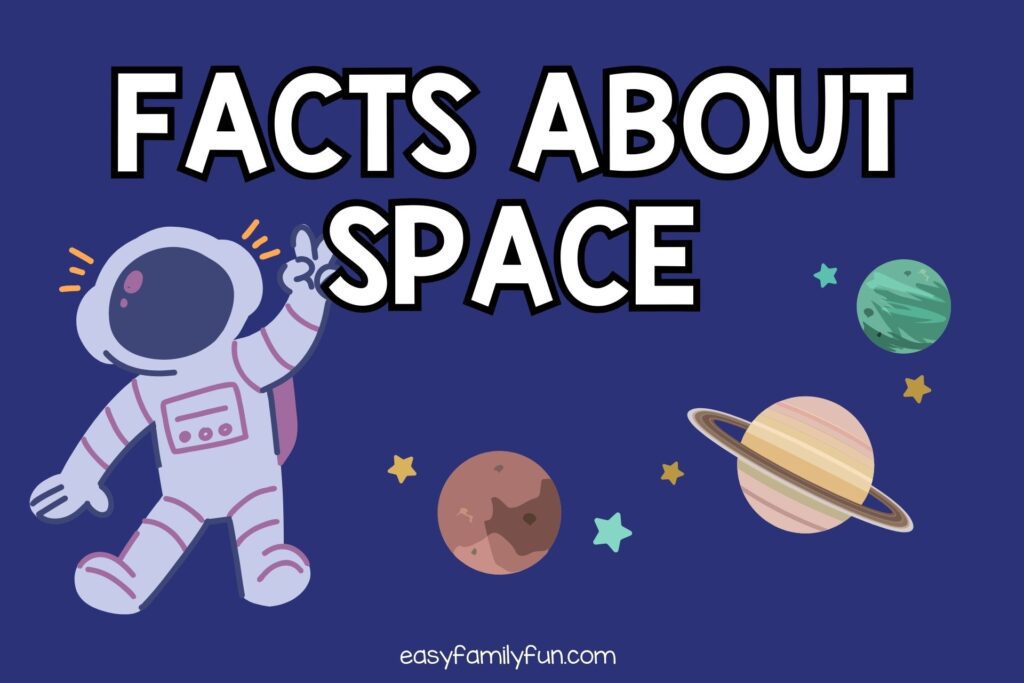
First up, did you know that space smells like seared steak and hot metal? Yes, you read that right! Astronauts have described the scent of space as a mix of burnt steak, gunpowder, and welding fumes. This strange smell is caused by the ionization of space dust and the disintegration of metal parts on spacecraft, creating a distinct aroma that is out of this world.
Want more facts about space? Did you know that some of the most expensive items ever sold were related to space exploration? In 2019, a lunar sample bag from the Apollo 11 mission sold at auction for a whopping $1.8 million! This small bag was used to collect the first samples of moon rocks during the historic mission, making it a valuable piece of space history.
But wait, there’s more facts about space that you don’t want to miss! Did you know that there’s a planet made entirely of diamonds? Yes, you heard that right! Scientists have discovered a planet called PSR J1719-1438 that is composed of solid diamond, with a mass greater than Jupiter. This sparkling celestial body is located 4,000 light-years away from Earth, and it’s estimated that its diamond core is worth around 26.9 nonillion dollars – that’s 30 zeroes!
And last but not least, did you know that space has its own weather? That’s right, space weather can affect the Earth’s magnetic field, causing beautiful auroras and disrupting satellite and communication systems. Solar flares, coronal mass ejections, and geomagnetic storms are just some of the phenomena that can occur in space, reminding us that even the vast emptiness of space is not immune to the forces of nature.
So, there you have it – a few lighthearted facts about space that are sure to make you smile. The universe is full of surprises and mysteries, and who knows what exciting discoveries we’ll make in the years to come!
Want to discover even more facts about space? Check out out list of over 100 facts about space to become a real space expert.
Love facts? Don’t stop with these! Be sure to check out our owl facts and our facts about Mexico.
Facts about Space

- Space does not begin at a specific altitude above Earth.
- Our solar system is 4.571 billion years old.
- The temperature in space is about -270.45 degrees C.
- No sound exists in space because molecules are too far apart to transmit sound.
- An estimated 100- 400 billion stars in our galaxy make up what we know as the Milky Way.
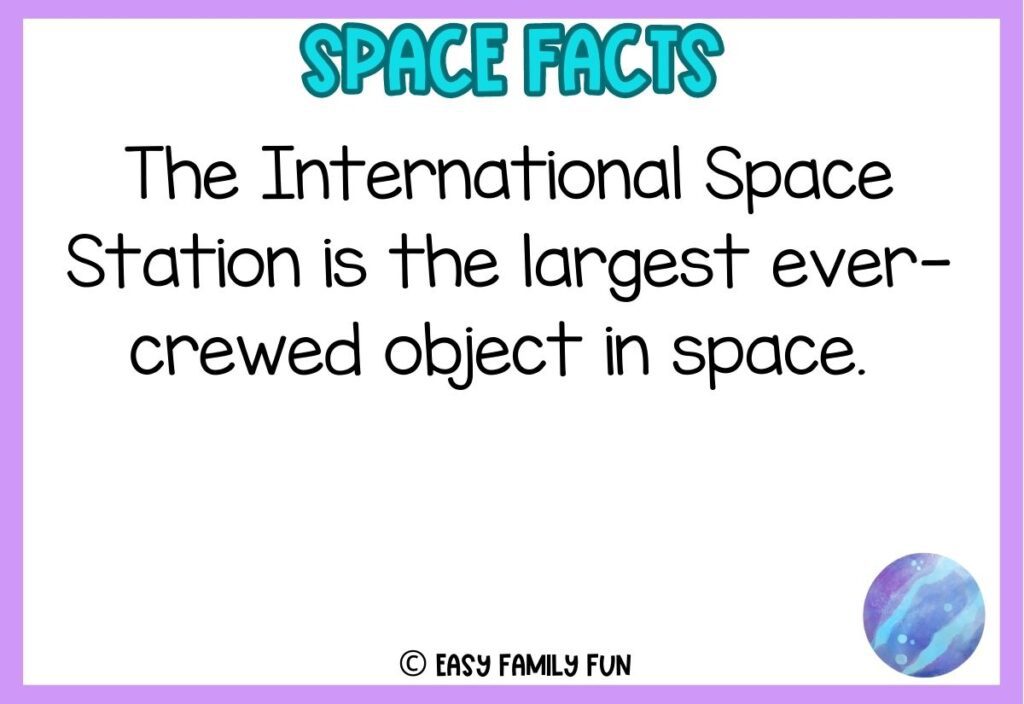
- The International Space Station is the largest ever-crewed object in space.
- Spacecraft have visited all the known planets in our solar system.
- The solar system contains small black holes.
- There is dark matter in space.
- There are 500 extrasolar planets have been found in space.
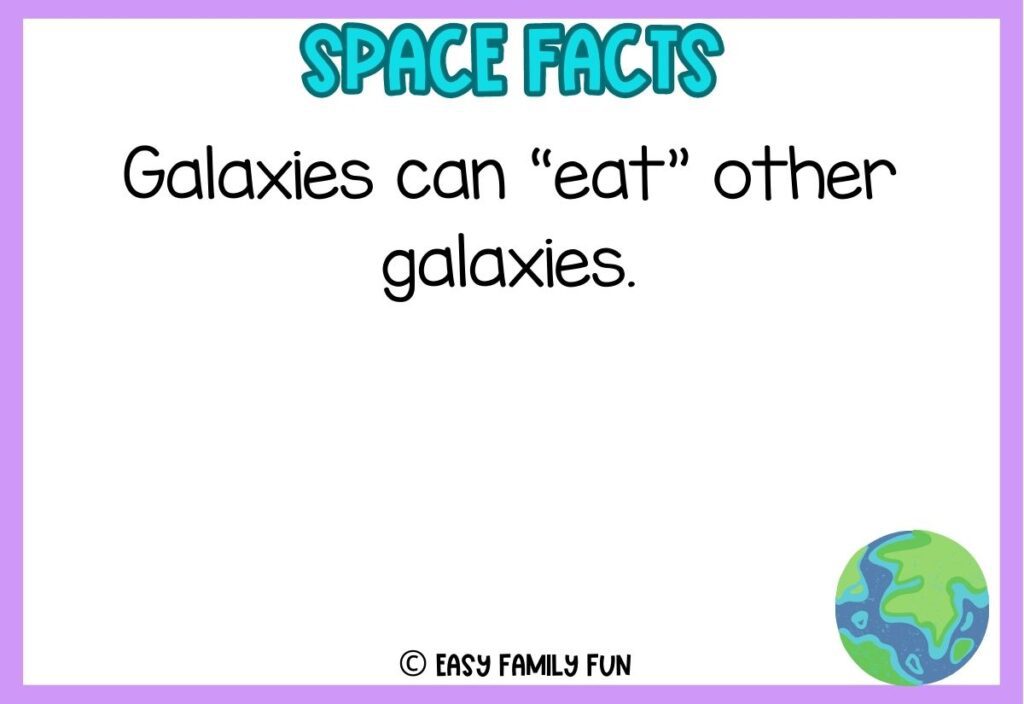
- Galaxies can “eat” other galaxies.
- If you scream in space, no one can hear you.
- A burning ice planet has been detected in space.
- Space is completely silent. It is a vacuum with no medium to travel, there are no sound waves.
- Venus is the hottest planet in our solar system. The average temperature is 232 degrees F.

- Mercury is the closest planet to the sun.
- Venus has the thickest atmosphere among all planets.
- Neuron stars are the densest and smallest stars in the universe. They can rotate up to 60 times per second after they are born from a supernova star explosion.
- The footprints on the moon will be there for 100 million years.
- If two pieces of the same type of metal touch in space, they will permanently bond.

- There is floating water in space.
- The largest known asteroid is 600 miles wide
- The Sun’s mass takes up 99.86% of the solar system.
- The Sun is made of ¾ hydrogen, and its remaining mass is helium.
- A volcano on Mars is three times the size of Everest.
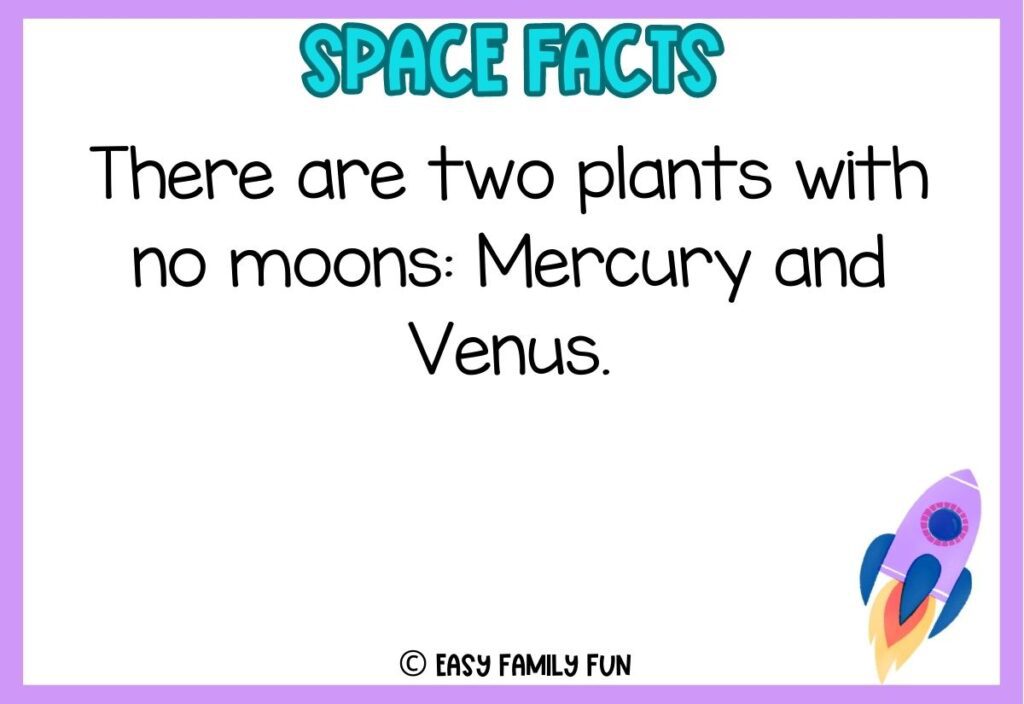
- There are two plants with no moons: Mercury and Venus.
- The planet Saturn has 82 known moons, and more are being found.
- Jupiter is the largest planet in the solar system and a failed star.
- Jupiter comprises Hydrogen and Helium but is not large enough to generate its own energy.
- Jupiter has a “Great Red Spot,” which is a storm that has been swirling for more than 100 years.

- Uranus is often called “the sideways planet,” and it orbits the Sun on its side. It is tilted about 98 degrees.
- Pluto has been reclassified as a dwarf planet, not a planet.
- A dwarf planet is a planet-like object that does not dominate the neighborhood of their orbit.
- Pluto’s largest move is about half the size of a dwarf planet.
- The 5 best-known dwarf planets in our Solar System are Ceres, Pluto, Makemake, Haumea, and Eris.
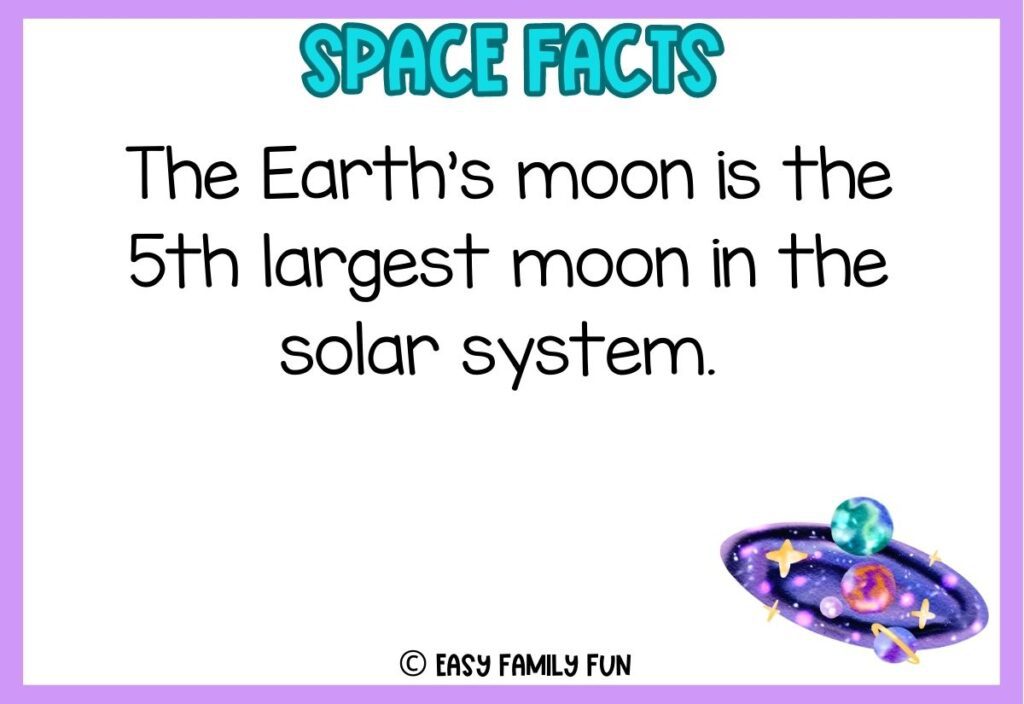
- The Earth’s moon is the 5th largest moon in the solar system.
- Saturn’s moon, Enceladus, is the most reflective body in the solar system.
- Enceladus, Saturn’s moon, has an icy shell that reflects about 1005 of the light that reaches it.
- The Moons of Uranus were named after Characters created by Alexander Pope and William Shakespeare.
- There are more starts in the universe than grains of sand in all the earth.

- The Sun is a main-sequence star. One million Earths can fit inside the Sun.
- Massive stars end their lives through supernova explosions.
- Galaxies are either elliptical, spiral, or irregular. These galaxy types are based on their appearance.
- The Milky Way is a spiral galaxy.
- Most galaxies have a black hole.

- All planets in the solar system have been visited by uncrewed spacecraft.
- The solar system’s boundary ends in a spherical cloud known as the Oort cloud.
- The International Space Station is about as wide as a soccer field.
- The International Space Station can be viewed from your backyard.
- Mars is knowns as the red planet because it is rich in iron.
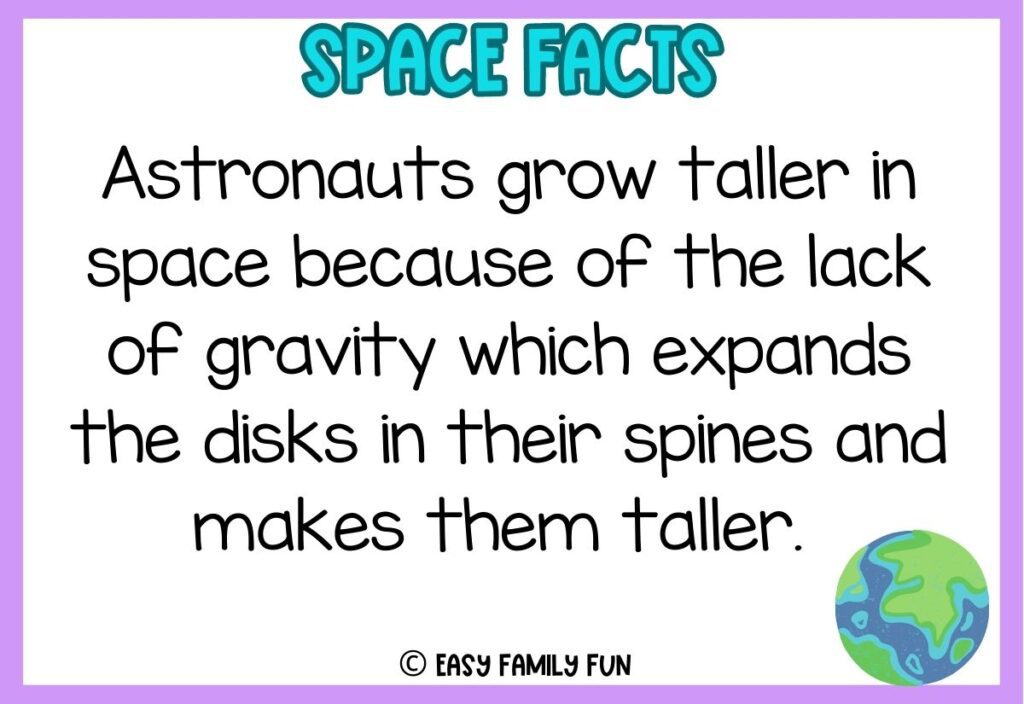
- Astronauts grow taller in space because of the lack of gravity which expands the disks in their spines and makes them taller.
- The closest star system to earth is Proxima Centauri is 4.25 light-years away.
- Extrasolar planets are located outside the solar system. They come in different sizes.
- Extragalactic plants are planets that are outside the Milky Way.
- Jupiter, Saturn, Uranus, and Neptune have all been observed having light shows known as auroras.
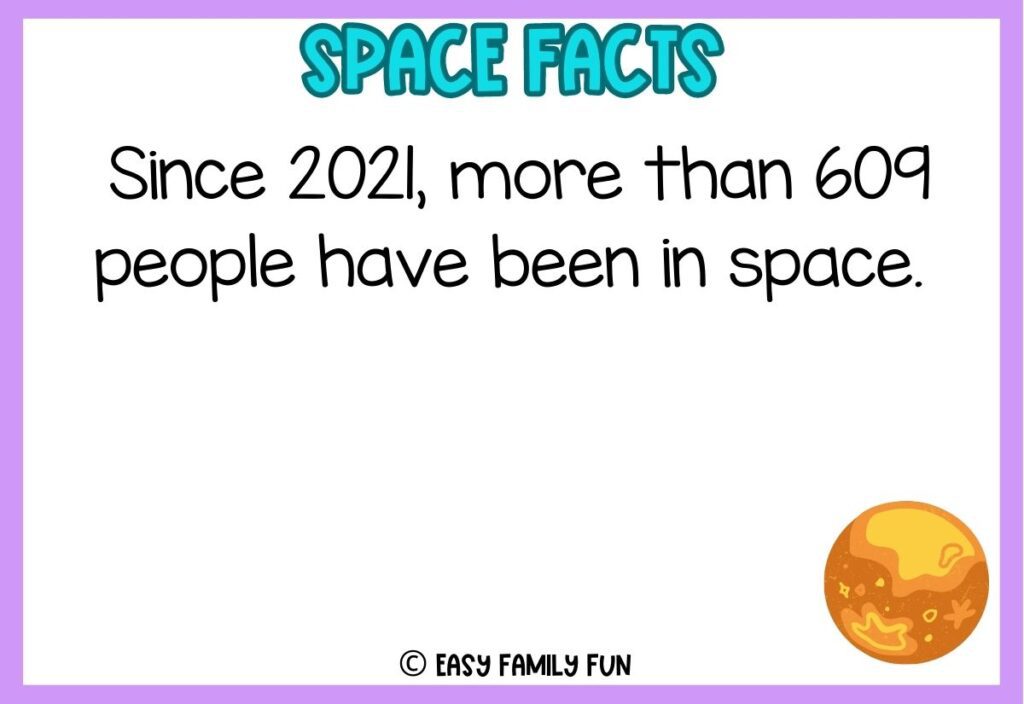
- Since 2021, more than 609 people have been in space.
- There are eight planets in our solar system: Mercury, Venus, Earth, Mars, Jupiter, Saturn, Uranus, and Neptune
- The planets in our solar system are divided into two main groups: Terrestrial Planets and Gas Giants.
- Exoplanets are planets that orbit other stars.
- Earth’s atmosphere protects from meteoroids and the Sun’s radiation.
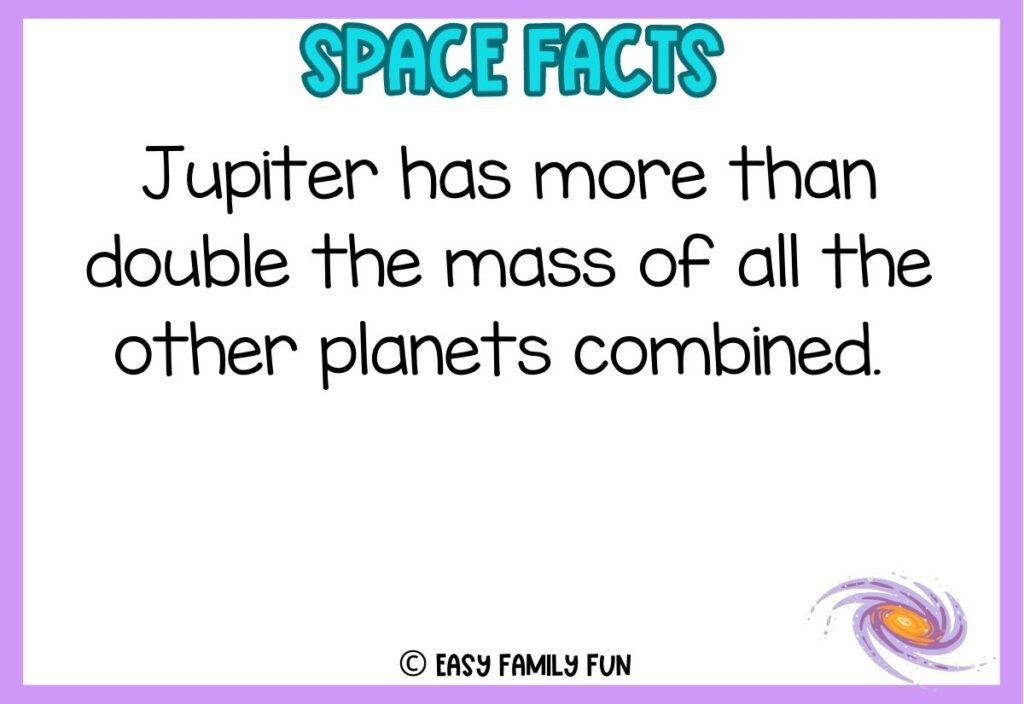
- Jupiter has more than double the mass of all the other planets combined.
- All planets, except for Earth, are named after God’s from Roman and Greek mythology.
- The planets listed in order of size, largest to smallest: Jupiter, Saturn, Uranus, Neptune, Earth, Venus, Mars, and Mercury.
- Planets are defined as a celestial body that orbits around the Sun.
- Space is a hard vacuum, which means it is a void that contains very little matter.
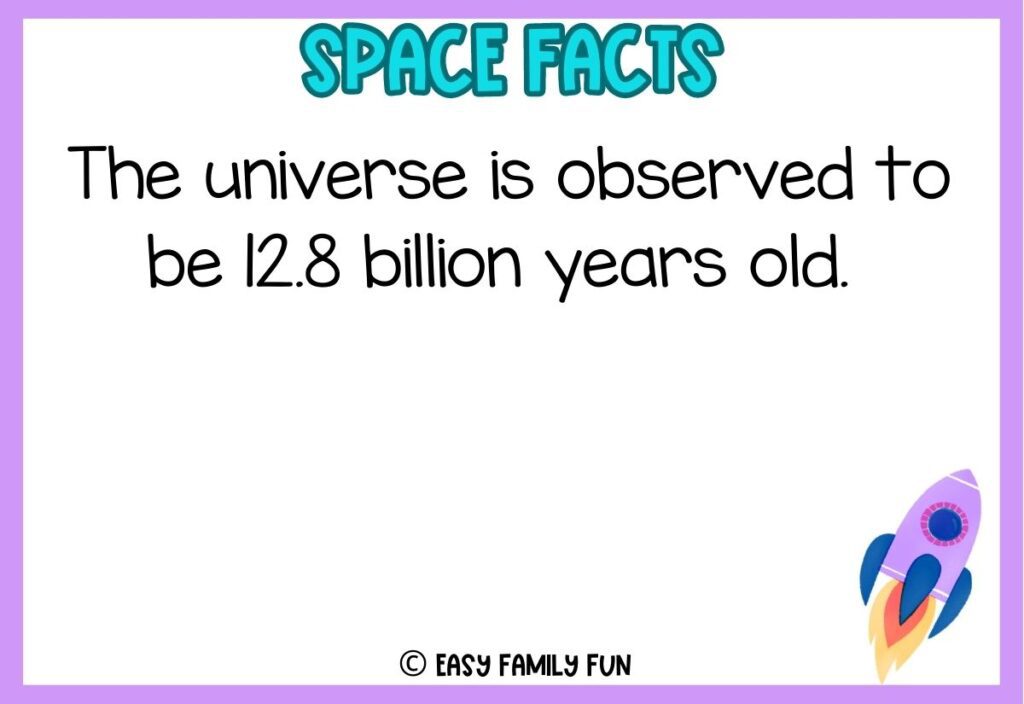
- The universe is observed to be 12.8 billion years old.
- The first person to look into space with a telescope was Galileo.
- Space is flexible and expanding.
- When water boils on Earth, it creates thousands of little bubbles, but because of lack of gravity, when water boils in space, it produces one giant, undulating bubble.
- The first American in Space was Alan Shephard (1961).
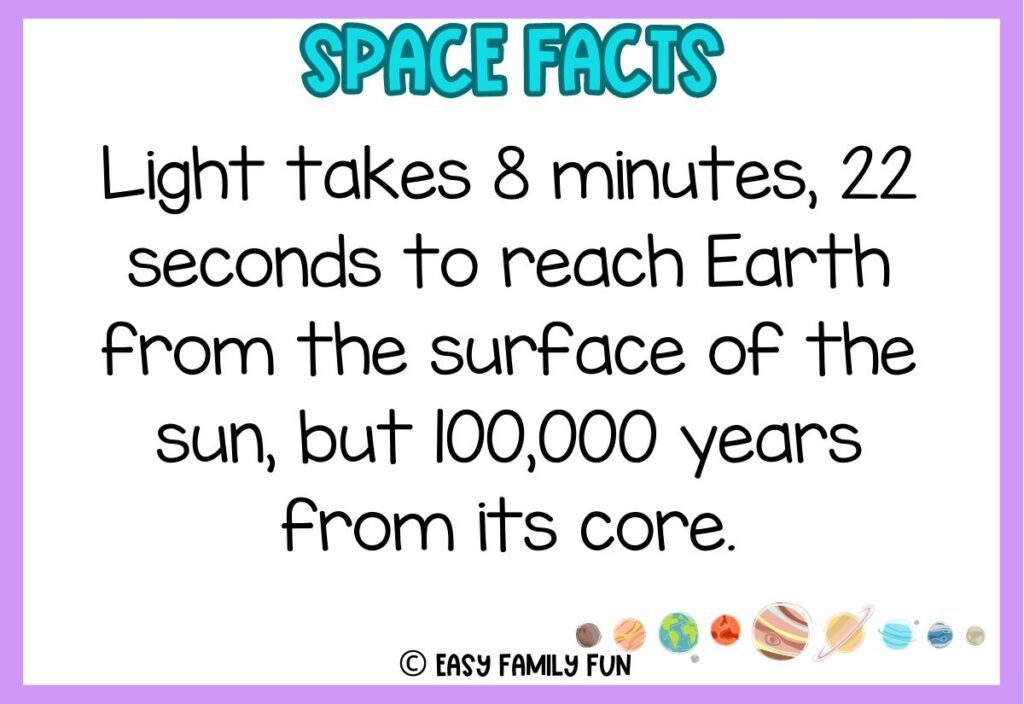
- Light takes 8 minutes, 22 seconds to reach Earth from the surface of the sun, but 100,000 years from its core.
- The reason space is so dark is because we can see the light only when it hits an object and bounces off of it.
- There have been six successful missions to put people on the Earth’s moon. A total of 12 astronauts explored the moon between 1969 and 1972.
- It will take the Sun around 200 million years to travel around our galaxy.
- Over 100 artificial satellites are launched into space each year.

- The Sun is white because of its extreme heat (10,340.33 degrees F). It only appears yellow because of the Earth’s atmosphere.
- Light always travels at 186,000 miles per second.
- Jupiter weighs more than twice as much as all our other planets together.
- The Sun can fit one million Earths inside it.
- If a star passes too close to a black hole, it can be torn apart.

- Venus is the hottest planet in the solar system.
- The International Space Station is a partnership between five space agencies from 15 countries.
- Olympus Mons is the largest known volcano in space.
- There is a planet called “55 Cancri e”, a Super-Earth” believed to be covered in graphite and diamonds.
- Venus is the second brightest natural object in the sky.
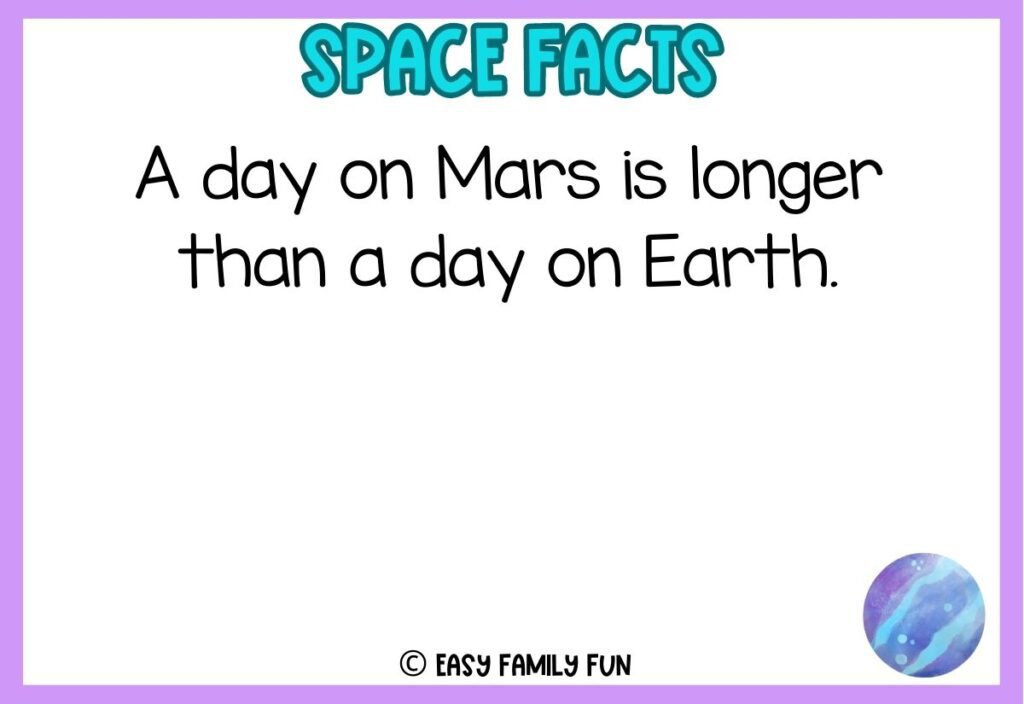
- A day on Mars is longer than a day on Earth.
- The rings on Saturn are named alphabetically based on when they were discovered.
- Mars has a canyon system that is larger than the Grand Canyon.
- Mercury is shrinking.
- Uranus’ blue glow is due to the gases in its atmosphere.
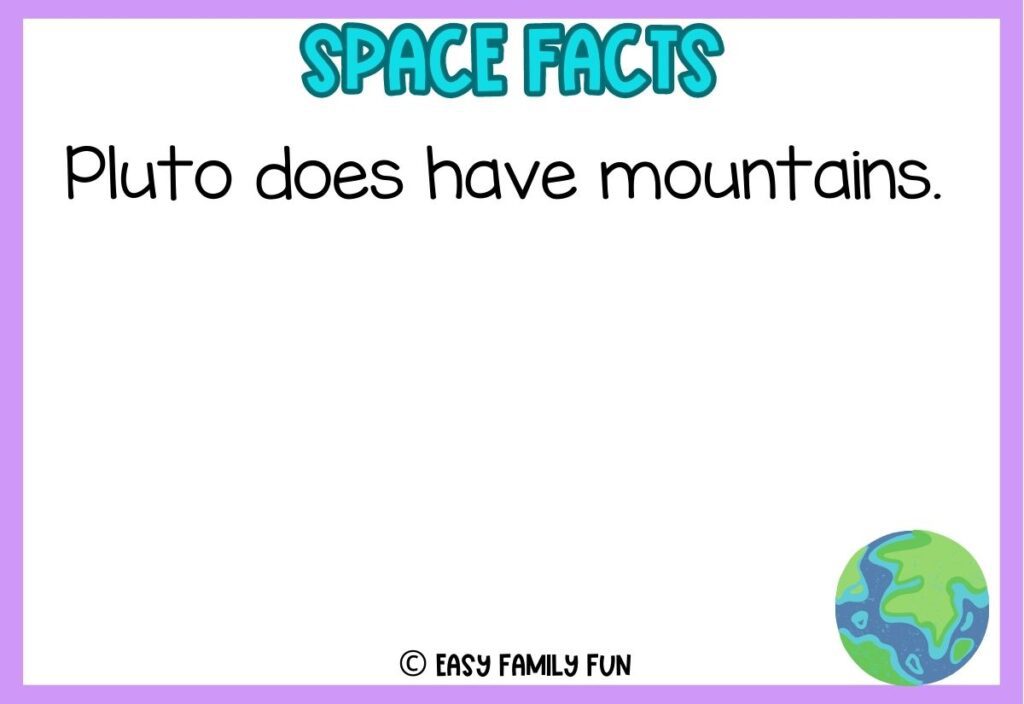
- Pluto does have mountains.
- The solar system has four planets known as “gas giants”: Jupiter, Saturn, Uranus, and Neptune.
- Any liquid floating in space will form the shape of a sphere.
- It would take a person 9 years to walk to the moon.
- The Sun is 400 times larger than the Moon and 400 times as far away, making both objects appear to be the same size in our sky.
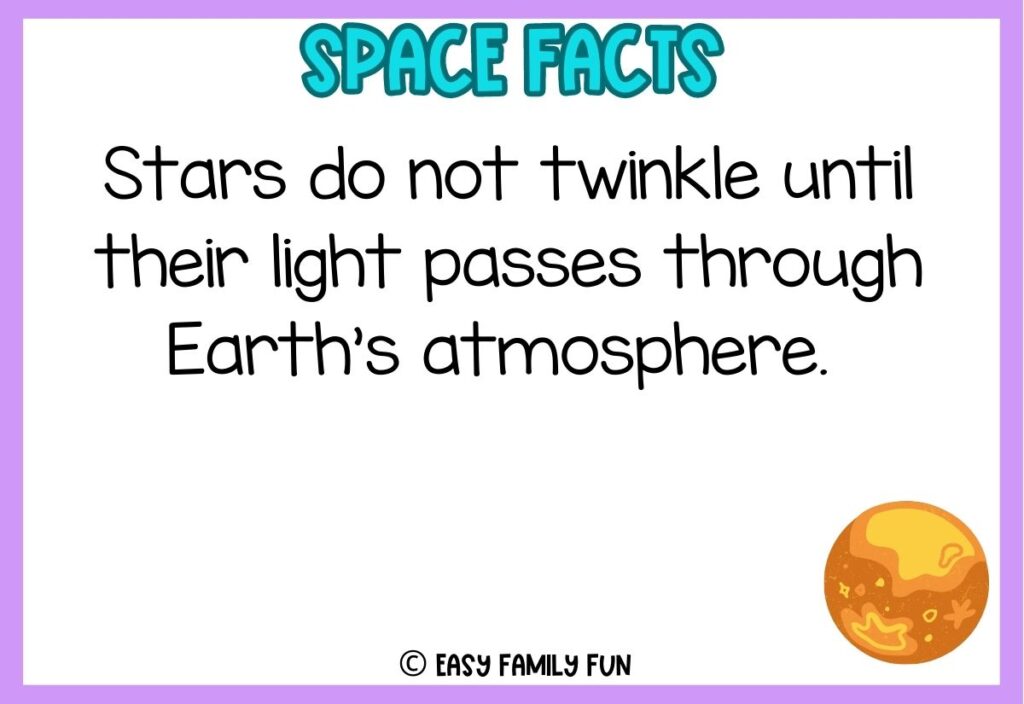
- Stars do not twinkle until their light passes through Earth’s atmosphere.
- If you drove a car to the nearest star at 70 mph, it would take more than 356 billion years.
- Neptune has a moon named Triton and is the coldest known object in the solar system.
- The International Space Station completes an orbit of Earth in about 90 minutes.
- Sunsets on the Red Planet are blue, small and long.

- Mercury’s temperature varies from -280 degrees F on its night side to 800 degrees F during the day.
- When the moon is half-full, it is only 10% as bright as the full moon.
- To escape Earth’s gravity, a spacecraft must travel more than 25,008 mph, Mach 33.
How many fascinating facts about space can you come up with off the top of your head? Do you know more space facts than we missed? Add them in the comments so we can add them to the list!
Are you looking for more fun and engaging facts to share with your family? Check out these other posts for more facts!
- 100 Fascinating Facts about Mexico
- 75 Fascinating Facts About France
- 100 Purr-fectly Delightful Facts About Cats
- 87 Fascinating Facts About Owls
- 103 Super Cool Facts About Space
- 100 Interesting Facts About Hurricanes
- Facts About the 9/11 Memorial
- Facts About Spring
- Facts About Rosa Parks
- 50 Fascinating Facts About Butterflies
- 50 Fascinating Facts About Eagles
- Facts About Rome
- Facts About Lions
- Facts about Big Ben
- 100 Best Facts About Quartz for Kids
- 100 Best Facts About Cheese For Kids
- 100 Best Facts About Canada for Kids
- 100+ Out-of-This-World Facts about Earth
- 100 Epic Bug Facts for Kids
- 100 Weird Facts About Animals for Kids
- 85 Stellar Facts About Jupiter
- 135 Fascinating Facts About Ireland That Will Make You Fall in Love
- 50+ Interesting Facts about the Nervous System [Fact Cards]
- 55 Interesting Facts About Seattle [Free Fact Cards]
- 55 Best Facts about Frogs [Free Fact Cards]
- 66 Best Facts About Blueberries [Free Fact Cards]
- 37 Best Facts About Bacon [Free Fact Cards]
- 65 Best Facts About Comets [Free Fact Cards]
- 85+ Best Titanic Facts [Free Fact Cards]
- Interesting Facts about Ladybugs [Free Fact Cards]
- Abraham Lincoln Facts You Should Know [Free Fact Cards]
- Dive Into These Facts About Jellyfish [Free Fact Cards]
- Interesting Banana facts [Free Fact Cards]
- 20 Interesting Facts About Red Wolves [Free Fact Cards]
- Mt. Rushmore Facts: Carving History in Stone [Free Fact Cards]
- 66 Best Facts About Blueberries [Free Fact Cards]
- Over 100 Fun Facts about North Carolina [Free Fact Cards]
- 79 Electrifying Facts about Lightning [Free Fact Cards]
- 56 Interesting Facts About Snakes [Free Fact Cards]
- 56 Interesting Facts About Snakes [Free Fact Cards]
- 53 Fascinating Facts about Spiders [Free Fact Cards]
- 74 Interesting Facts About New Zealand [Free Fact Cards]
- 50 Interesting Facts About Apples [Free Fact Cards]
- 100 Purr-fectly Delightful Facts About Cats
- Buzzing with Knowledge: Explore 65 Fascinating Facts About Bees!
- 100 Marvelous Facts About Monkeys
- Gallop Through Knowledge: With These 75 Fascinating Facts about Horses
- Travel Back in Time With These Facts About the 13 Colonies!
- 52 Facts About Neptune for the Future Astronauts in Your Family
- 40 Incredible Facts About Your Heart
- 25 Remarkable Facts about James Madison
- 35 Oink-some Facts About Pigs
- 50 Neck-Stretching Facts about Giraffes
- 65 Patriotic Facts about the Statue of Liberty
- 50 Incredible Facts About Turtles
- 40 Mischievous Facts About Raccoons
- 135 Fascinating Facts About Ireland That Will Make You Fall in Love
- 85 Stellar Facts About Jupiter
- 100 Weird Facts About Animals for Kids
- 100 Epic Bug Facts for Kids
- 100+ Out-of-This-World Facts about Earth
- 100 Best Facts About Canada for Kids
- 100 Best Facts About Cheese For Kids
